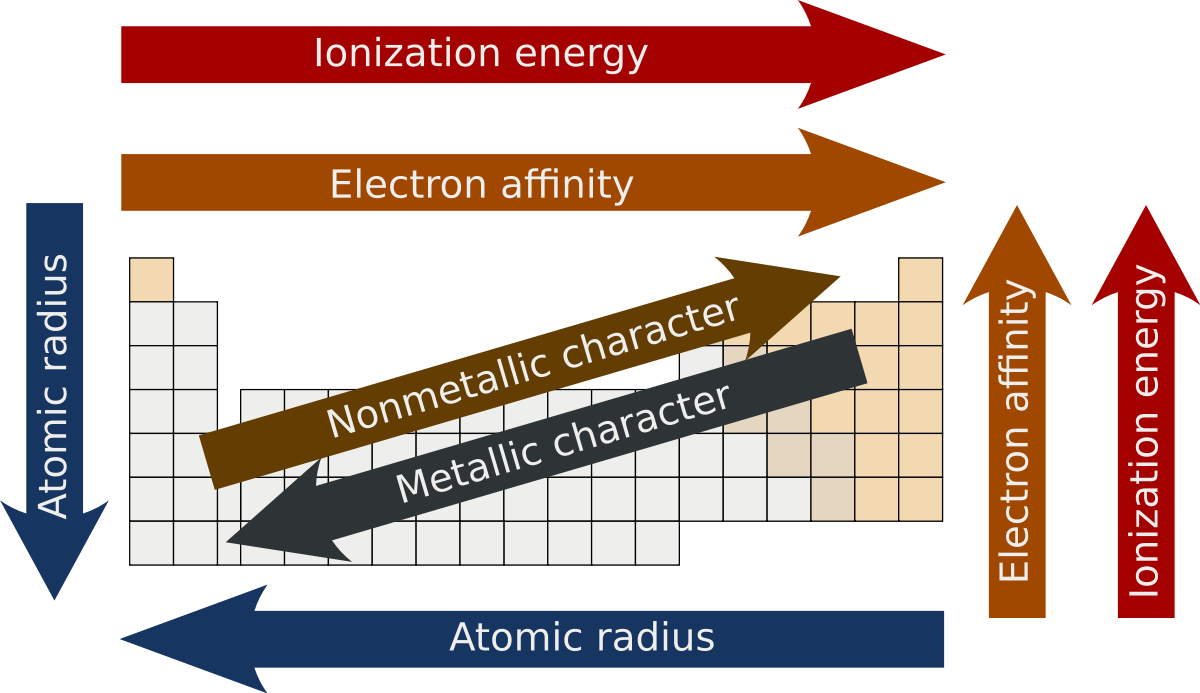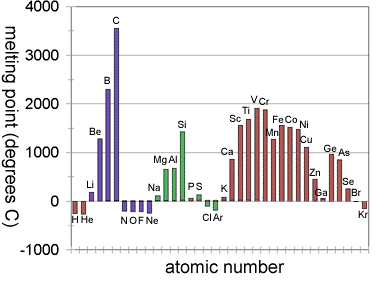3.2 Periodic trends
Written specifically for students to provide help and support for the IB Diploma chemistry programme this page provides full coverage of the syllabus content of Topic 3.2 Periodic trends. It encourages you to think critically and provides many questions with full worked answers so that you can monitor and improve your knowledge and understanding.


 Learning outcomes
Learning outcomes
After studying this topic you should be able to:
 Understand:
Understand:
- Atomic radius, ionic radius, ionization energy, electron affinity and electronegativity all show vertical and horizontal trends in the periodic table.
- The trends in metallic and non-metallic behaviour are due to the above trends.
- Across a period the nature of the oxides changes from basic through amphoteric to acidic.
Apply your knowledge to:
- Predict and explain the metallic and non-metallic behaviour of an element based on its position in the periodic table.
- Discuss the similarities and differences in the properties of elements in the same group, (limited to the alkali metals, group 1, and the halogens, group 17).
- Construct equations to explain the changes in pH for the reactions of sodium oxide, Na2O, magnesium oxide, MgO, phosphorus(V) oxide, P4O10, and the oxides of nitrogen and sulfur with water.
- Describe and explain the trends in atomic radii, first ionization energies and electronegativities for elements across period 3.
Relationships & vocabulary
Nature of science
Scientists are able to make accurate predictions about the physical and chemical properties of an element based on its position in the periodic table. By identifying and using patterns scientists are able to synthesize new substances based on the expected reactivity of elements.
International-mindedness
Because of industrialization, many products are produced that cause global problems when released into the environment.
For examples and more links to International mindedness, Theory of knowledge, utilization etc. see separate page which covers all of Topics 3 & 13: Periodicity.
Vocabulary
| first ionization energy | electronegativity | atomic radius | ionic radius |
| isoelectronic | Pauling's scale of electronegativities | amphoteric |
Learning slides
You can use this slide gallery for learning or for reviewing concepts and information. It covers all the key points in the syllabus for this sub-topic.
Something to think about
1. The graph of first ionization energies against atomic number (see Topics 2 & 12 : Atomic structure) exemplifies periodicity in classic style. But periodicity is not always so clear cut when other properties of the elements are plotted against atomic number. For example, consider the graph for melting points.

Graph of melting points plotted against atomic number for the first 36 elements.
There are some signs of periodicity. For example, carbon, silicon and germanium (group 14) follow a trend, but look at groups 2 and 13. Boron is much higher than beryllium (period 2), magnesium and aluminium are virtually the same (period 3) and gallium is lower than calcium (period 4). Get students to plot other graphs and see how obvious the concept of periodicity really is. It will make them appreciate the genius of Mendeleev even more.
2. A knowledge of the chemical properties of the elements and oxides of period 3 can have practical uses. Many motorcycles produced in the 1950s, such as this classic T100 Triumph Tiger mIB Docs (2) Teamfactured in 1951, had aluminium alloy engines.

1951 T100 Triumph Tiger motorcycle with an alloy engine
They were renowned for leaking oil and one of the ways some people tried to clean the engines to remove the grease and oil was with oven cleaner. Not a good idea. Some oven cleaners contain sodium hydroxide or potassium hydroxide. This reacts with the amphoteric aluminium oxide layer on the engine and then, in turn, with the exposed aluminium underneath to turn the motorcycle engine into sodium (or potassium aluminate) and potentially explosive hydrogen gas!
Test your understanding of this topic
(Note that your teacher may have restricted your access to some or all of these questions and worked answers if they are going to use them as a class test or set them as an assignment.)
For ten 'quiz' multiple choice questions with the answers explained see MC test: Periodic trends.
For short-answer questions see Periodic trends questions.
More resources
1. The Interactive periodic table produced by Brain Adams for touchspin has already been mentioned in Topics 3 & 13 : Periodicity. The Royal Society of Chemistry has also produced a good data base for periodic trends.
2. This might be an interesting video for you to look at and consider how this topic is best presented to you so you can fully understand it. Some of the comments that students have written underneath are worth looking at.
3. The classic video clip from the Royal Society of Chemistry (or was it the Open University?) of the alkali metals reacting with water.
4. And now for the Brainiac version of the same reactions. Much more exciting and students love it but better for TOK than for genuine chemistry! Look out for the perfect let-out clause, "Only on Brainiac do you get that kind of science".
Brainiac alkali metals with water ![]()
5. A nice video to show from the Open University on the chemistry of the four halogens, fluorine, chlorine, bromine and iodine.

 IB Docs (2) Team
IB Docs (2) Team 




































